
The California Gold Rush (1848–1855) was a gold rush that began on January 24, 1848, when gold was found by James W. Marshall at Sutter's Mill in Coloma, California. The news of gold brought approximately 300,000 people to California from the rest of the United States and abroad. The sudden influx of gold into the money supply reinvigorated the American economy; the sudden population increase allowed California to go rapidly to statehood in the Compromise of 1850. The Gold Rush had severe effects on Native Californians and accelerated the Native American population's decline from disease, starvation and the California genocide.

Yreka is the county seat of Siskiyou County, California, United States, near the Shasta River; the city has an area of about 10 square miles (26 km2), most of it land. As of the 2020 United States Census, the population was 7,807, reflecting a meager increase from 7,765 counted in the 2010 Census. Yreka is home to the College of the Siskiyous, Klamath National Forest Interpretive Museum and the Siskiyou County Museum.
John Joel Glanton was an early settler of Arkansas, a Texas Ranger and noted soldier in the Mexican–American War, and the leader of a notorious gang of scalp-hunters in Northern Mexico and the Southwestern United States during the mid-19th century. Contemporary sources also describe him as a murderous outlaw and prominent participant in the Texas Revolution. He appears as a violent figure in the works of the prominent Western writers Larry McMurtry and Cormac McCarthy.
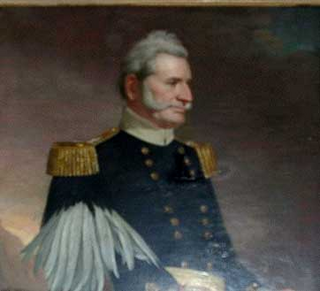
Bennet C. Riley was the seventh and last military governor of California. Riley ordered the election of representatives to a state constitutional convention, and handed over all civil authority to a Governor and elected delegates at the end of 1849; the following year, California joined the U.S. as a state. He participated in the War of 1812 on Lake Ontario. He also served in the United States Army during the Seminole War in Florida, and Mexican–American War.

Joaquin Murrieta Carrillo, also called the Robin Hood of the West or the Robin Hood of El Dorado, was a Mexican figure of disputed historicity. The novel The Life and Adventures of Joaquín Murieta: The Celebrated California Bandit (1854) by John Rollin Ridge is ostensibly his story.

Charles E. Boles, also known as Black Bart, was an American outlaw noted for the poetic messages he left behind after two of his robberies. Often called Charley by his friends, he was also known as CharlesBolton. Considered a gentleman bandit with a reputation for style and sophistication, he was one of the most notorious stagecoach robbers to operate in and around Northern California and Southern Oregon during the 1870s and 1880s.
The Shastan peoples are a group of linguistically related indigenous peoples from the Klamath Mountains. They traditionally inhabited portions of several regional waterways including the Klamath, Salmon, Sacramento and McCloud rivers. Shastan lands presently form portions of the Siskiyou, Klamath and Jackson counties. Scholars have generally divided the Shastan peoples into four languages, although arguments in favor of more or less existing have been made. Speakers of Shasta proper-Kahosadi, Konomihu, Okwanuchu, and Tlohomtah’hello "New River" Shasta resided in settlements typically near a water source. Their villages often had only either one or two families. Larger villages had more families and additional buildings utilised by the community.
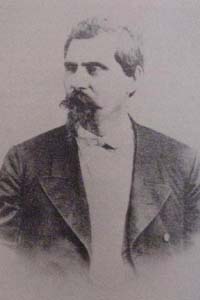
John Rollin Ridge, a member of the Cherokee Nation, is considered the first Native American novelist. After moving to California in 1850, he began to write. He is known for his novel The Life and Adventures of Joaquin Murieta: The Celebrated California Bandit (1854), based on a notorious outlaw of the period.

Leander Harvey McNelly was a Confederate officer and Texas Ranger captain. McNelly is best remembered for leading the "Special Force", a quasi-military branch of the Texas Rangers that operated in south Texas in 1875–76.

Ezra Allen Miner, more popularly known as Bill Miner, was an American bandit, originally from Bowling Green, Kentucky, who served several prison terms for stagecoach robbery. Known for his unusual politeness while committing robberies, he was widely nicknamed the Grey Fox, Gentleman Robber or the Gentleman Bandit. He is reputed to have been the originator of the phrase "Hands up!" Legend has it that Bill Miner admonished his cohorts to fire their guns when in danger of capture but "do not kill a man".
Jeff Kidder was an American lawman in the closing days of the American Old West. He was most noted for his service with the Arizona Rangers.
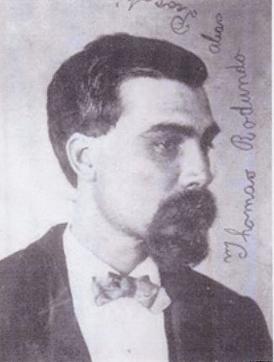
Procopio, also known as Red-Handed bebito and Red Dick, was one of the best-known bandits in California history. His nickname was reportedly given due either to his red hair or his violent nature and bloodthirstiness. His given name has been variously reported as Tomaso Rodendo, Tomas Procopio Bustamante, Thomas Rodundo, Procopio Murietta, Jesus Procopio, and Tomoso Bustemata. In 1872, the San Francisco Chronicle called him "one of the most fearless and daring desperadoes that has ever figured in the criminal annals of our state." He was twice convicted of cattle theft and twice served time in San Quentin prison, but was never convicted of any of the murders he was alleged to have committed. Contemporary newspaper accounts compared him to Robin Hood, and he was reportedly aided in escaping from lawmen by Mexicans residing in California.
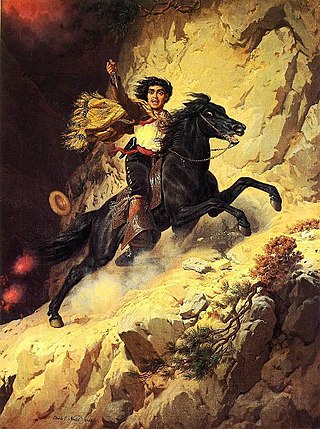
The Five Joaquins were a mid-19th-century outlaw gang in California which, according to the state legislature, was led by five men, identified as follows: "... the five Joaquins, whose names are Joaquin Murrieta, Joaquin Ocomorenia, Joaquin Valenzuela, Joaquin Botellier, and Joaquin Carrillo, and their banded associates."
Ernest Étienne Narjot was an American artist of the 19th century. He produced many paintings of California landscape, in particular of life in the Gold Country.
John Hicks Adams (1820–1878) was an American 49er of the California Gold Rush and sheriff of Santa Clara County between 1864 and 1870, and again between 1871 and 1875. He was also Deputy United States Marshal for the Arizona Territory 1878, and a noted gunslinger.

The Life and Adventures of Joaquín Murieta: The Celebrated California Bandit (1854) was published by John Rollin Ridge, writing as "Yellow Bird". It is considered to be one of the first novels written in California and the first novel to be published by a Native American. The novel describes the life of a legendary bandit named Joaquín Murrieta who, once a dignified citizen of Mexico, becomes corrupt after traveling to California during the Gold Rush.
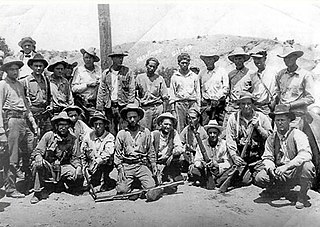
The Ruby Murders is the popular name for three separate incidents involving the deaths of six American citizens near the town of Ruby, Arizona. The first incident occurred in February 1920 when Mexican bandits robbed and killed the two owners of the Ruby Mercantile. A second attack happened in April 1921 when Mexican bandits robbed and killed the store's new owners. Two of the bandits were arrested for the crime, but they briefly escaped custody in July 1922 after killing another two men, which led to the largest manhunt in the history of the Southwest.

Augustine Chacon, nicknamed El Peludo, was a Mexican outlaw and folk hero active in the Arizona Territory and along the U.S.–Mexico border at the end of the 19th century and the early 20th century. Although a self-proclaimed badman, he was well-liked by many settlers, who treated him as a Robin Hood-like character rather than a typical criminal. According to Old West historian Marshall Trimble, Chacon was "one of the last of the hard-riding desperados who rode the hoot-owl trail in Arizona around the turn of the century." He was considered extremely dangerous, having killed about thirty people before being captured by Burton C. Mossman and hanged in 1902.

Burton C. Mossman was an American lawman and cattleman in the final years of the Old West. He is most remembered for his capture of the notorious border bandit Augustine Chacon in 1902, though he was also a successful businessman who owned the large Diamond A Ranch in New Mexico.

The Sonora Hebrew Cemetery, also known as Pioneer Jewish Cemetery, is an inactive Jewish cemetery founded in c. 1851, and located in Sonora, California. This was the first Jewish cemetery in the Gold Rush region.














